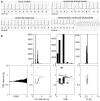New methods for the analysis of heartbeat behavior in risk stratification
- PMID: 22144963
- PMCID: PMC3225924
- DOI: 10.3389/fphys.2011.00088
New methods for the analysis of heartbeat behavior in risk stratification
Abstract
Developing better methods for risk stratification for tachyarrhythmic sudden cardiac remains a major challenge for physicians and scientists. Since the transition from sinus rhythm to ventricular tachycardia/fibrillation happens by different mechanisms in different people, it is unrealistic to think that a single measure will be adequate to provide a good index for risk stratification. We analyze the dynamical properties of ventricular premature complexes over 24 h in an effort to understand the underlying mechanisms of ventricular arrhythmias and to better understand the arrhythmias that occur in individual patients. Two dimensional density plots, called heartprints, correlate characteristic features of the dynamics of premature ventricular complexes and the sinus rate. Heartprints show distinctive characteristics in individual patients. Based on a better understanding of the natures of transitions from sinus rhythm to sudden cardiac and the mechanisms of arrhythmia prior to cardiac arrest, it should be possible to develop better methods for risk stratification.
Keywords: cardiac arrhythmias; early after depolarization; non-linear dynamics; parasystole; sudden cardiac death; ventricular tachycardia.
Figures


Similar articles
-
Predicting the risk of sudden cardiac death.J Physiol. 2016 May 1;594(9):2445-58. doi: 10.1113/JP270535. Epub 2016 Feb 2. J Physiol. 2016. PMID: 26660287 Free PMC article. Review.
-
The relation of ventricular arrhythmia electrophysiological characteristics to cardiac phenotype and circadian patterns in hypertrophic cardiomyopathy.Europace. 2012 May;14(5):724-33. doi: 10.1093/europace/eur362. Epub 2011 Nov 16. Europace. 2012. PMID: 22094454
-
[Detection of patients at risk for sudden heart death by long-term ECG. The role of life-threatening ventricular arrhythmias].Herz. 1984 Feb;9(1):6-25. Herz. 1984. PMID: 6200415 German.
-
A comparison of T-wave alternans, signal averaged electrocardiography and programmed ventricular stimulation for arrhythmia risk stratification.J Am Coll Cardiol. 2000 Dec;36(7):2247-53. doi: 10.1016/s0735-1097(00)01017-2. J Am Coll Cardiol. 2000. PMID: 11127468
-
Ventricular Arrhythmias in Apparently Normal Hearts: Who Needs an Implantable Cardiac Defibrillator?Card Electrophysiol Clin. 2016 Sep;8(3):613-21. doi: 10.1016/j.ccep.2016.04.010. Epub 2016 Jun 28. Card Electrophysiol Clin. 2016. PMID: 27521094 Review.
Cited by
-
Ectopic cycle length estimation from the quantified distribution patterns of ventricular bigeminy and trigeminy.Heart Rhythm O2. 2021 Mar 10;2(2):138-148. doi: 10.1016/j.hroo.2021.03.003. eCollection 2021 Apr. Heart Rhythm O2. 2021. PMID: 34113916 Free PMC article.
-
The Movesense Medical Sensor Chest Belt Device as Single Channel ECG for RR Interval Detection and HRV Analysis during Resting State and Incremental Exercise: A Cross-Sectional Validation Study.Sensors (Basel). 2022 Mar 5;22(5):2032. doi: 10.3390/s22052032. Sensors (Basel). 2022. PMID: 35271179 Free PMC article.
-
An introduction to heart rate variability: methodological considerations and clinical applications.Front Physiol. 2015 Feb 25;6:55. doi: 10.3389/fphys.2015.00055. eCollection 2015. Front Physiol. 2015. PMID: 25762937 Free PMC article. No abstract available.
-
Predicting the risk of sudden cardiac death.J Physiol. 2016 May 1;594(9):2445-58. doi: 10.1113/JP270535. Epub 2016 Feb 2. J Physiol. 2016. PMID: 26660287 Free PMC article. Review.
-
The interplay of heart rate variability and ventricular repolarization parameters in the obese state: a review.Cardiovasc Endocrinol Metab. 2025 Jan 9;14(1):e00323. doi: 10.1097/XCE.0000000000000323. eCollection 2025 Mar. Cardiovasc Endocrinol Metab. 2025. PMID: 39802372 Free PMC article. Review.
References
-
- Aguado-Sierra J., Krishnamurthy A., Villongco C., Chuang J., Howard E., Gonzales M. J., Omens J., Krummen D. E., Narayan S., Kerckhoffs R. C., McCulloch A. D. (2011). Patient-specific modeling of dyssynchronous heart failure: a case study. Prog. Biophys. Mol. Biol. (in press).10.1016/j.pbiomolbio.2011.06.014 - DOI - PMC - PubMed
LinkOut - more resources
Full Text Sources

